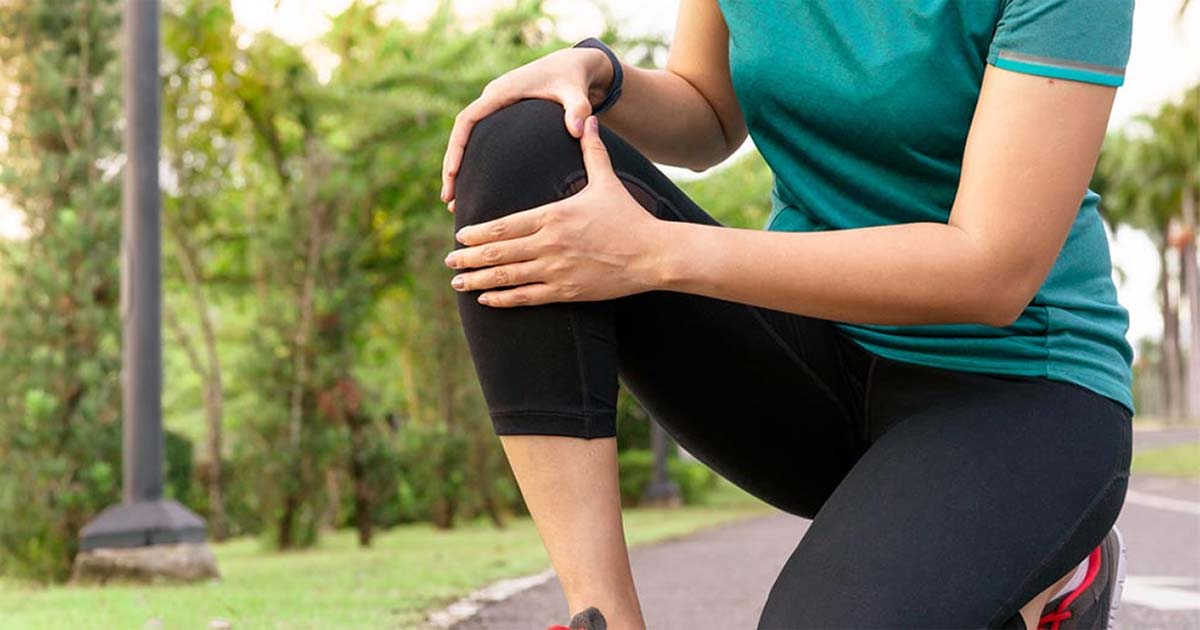
Advice to improve your movement, fitness, and overall health from the #1 in orthopedics in the U.S.
What Does a Pop in Your Knee Mean?
Decipher every snap, crackle and pop with this advice from a knee surgeon.
Advice to improve your movement, fitness, and overall health from the #1 in orthopedics in the U.S.
You’re getting up from your seat, walking across the room, or doing a weighted squat, and suddenly, a “pop” emanates from your knee. Should you be worried?

Not necessarily. “Most of the time, a popping sound is harmless,” says HSS orthopedic surgeon Dr. Sabrina Strickland. The official name for this noise is “crepitus” and there are several perfectly innocent reasons it can happen. Many times, the sound simply means air or gas bubbles have built up in the fluid around the joints and the cracking is those tiny bubbles bursting. Other times, knee crepitus can indicate early or even moderate osteoarthritis. “As the cartilage wears down, the underside of the kneecap rubs against the front of the thighbone, and a bend in the knee can cause a crackly, crunchy, creaky, or even pop-like sound,” says Dr. Strickland.
If you think you have osteoarthritis in your knee, you may want to consult a sports medicine physician or an orthopedic surgeon to make sure, especially if you are experiencing pain.
Injuries can also initiate knee pops. They include:
ACL tear
This is the most common injury associated with a pop. The anterior cruciate ligament (ACL) is one of four major ligaments in the knee joint. It helps maintain the knee's rotational stability and prevents the tibia (shinbone) from slipping in front of the femur (thighbone). ACL tears, either partial or full, are especially common among people who play sports that require a lot of quick changes in direction, such as tennis, soccer, basketball and skiing. Active women are particularly at risk for tearing their ACL because their biomechanics tend to put more stress on their knees.
When a person tears their ACL, they usually hear or feel the pop at the time of the tear. The knee will quickly swell and often feel unstable. In less severe tears, the symptoms may be mild, while complete tears leave the person unable to land on the knee after a jump, accelerate then change directions, or pivot quickly.
While an ACL tear won’t heal on its own, not everyone needs surgery to repair it. “It really depends on which activities you want to get back to,” says Dr. Strickland. “You may get away without an ACL and still swim or do sports that work your knee in a straight line, like walking, jogging or cycling,” she says. But for activities that need a stable knee to twist or change direction, like skiing or tennis, an intact ACL is crucial.
Meniscus tear
The meniscus, a C-shaped piece of cartilage, spans the space between the thighbone and the shinbone. It acts as a shock absorber, keeping the bones of the knee joint from grinding against one other, and also helps transmit the load of your weight evenly across the knee joint.
A meniscus tear can happen while playing a sport where you twist your knee, like tennis or basketball, but it can sometimes tear when doing something as simple as a deep knee bend. Since less than the outer third of the meniscus contains blood vessels, the inner part never heals or regenerates. “Every step that you take, every time you go running, every time you jump off a step, you wear it down, so it’s very common to tear it without any significant trauma, particularly if you’re over 40,” says Dr. Strickland.
The key symptom of a meniscus tear is pain in the knee joint. A tear may also cause the knee to swell or bruise, and prompt a locking or catching sensation as the fragments of the meniscus gets caught inside the knee. The knee may also feel weak or give way for no apparent reason.
Unfortunately, because of the lack of blood supply, the meniscus can’t heal itself; however, not everyone needs surgery. Nonsurgical treatments, such as anti-inflammatory medications and rehabilitation with a physical therapist can help reduce the pain and strengthen and restore full motion of the knee. Other people will need surgery, which usually involves either a trimming or repair of the meniscus.
MCL tear
The medial collateral ligament (MCL) is located along the inner side of the knee, stretching from the thighbone to the shinbone and helps to stabilize the inner part of the knee. “MCL tears often happen while skiing, when the knee is subjected to a valgus force that causes the tibia to bend outwards relative to the femur,” says Dr. Strickland.
The pain is usually along the inner part of the knee, and there may be swelling and bruising. The good news is that MCL tears almost always heal on their own, and treatment consists of immediate rest, ice, compression, and elevation (RICE). For higher grade tears, patients benefit from use of a hinged knee brace to keep the ligament from stretching as it heals.
Baker’s cyst rupture
Many people don’t even know when they have one of these fluid-filled cysts that develop on the back of the knee. “Out of the blue, these harmless cysts can pop, causing the calf to swell and become discolored,” says Dr. Strickland. The pop is often accompanied by a sharp pain in the knee, and sometimes the feeling of fluid running down the calf. For most people, there’s no need for treatment, other than RICE. However, sometimes Baker’s cysts are due to problems with the knee joint, such as arthritis or a tear in the cartilage. “If that’s the case, we’ll have to treat the root cause,” says Dr. Strickland.
Patella subluxation
For most people, the kneecap, or patella, glides smoothly within a V-shaped groove in the thigh bone called the trochlea. As you bend and straighten the knee, the patella moves up and down and is stable within the trochlea, allowing you to stand, sit, walk, and run without a problem. But sometimes the kneecap partially goes off the trochlear groove, which is called patella subluxation, or can even fully dislocate. “When this happens, the knee swells, pops, or snaps,” says Dr. Strickland. This typically happens with younger people (under 25) who have a shallow groove.
Sometimes the kneecap can return to its proper place on its own. If not, a doctor can push it back in with gentle pressure, a process called reduction. Afterwards, rest, a knee brace, and crutches will help the swelling to go down and allow the knee to recover. Depending on the age of the patient, associated injuries and radiologic measurements some patients may require surgery to stabilize the patella.
Published 4/5/2022


